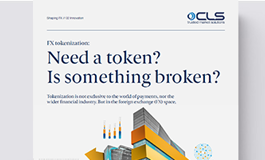Innovation 02 | FX tokenization: Need a token? Is something broken? | ShapingFX series
Tokenization is not exclusive to the world of payments, nor the wider financial industry. But in the foreign exchange (FX) space, interest is increasing, research is ramping up, and numerous initiatives are exploring the potential benefits of tokenization. Though tokenization is more established in the securities sphere, the payments space has not yet reached a consensus on what should be tokenized or how. In the wholesale FX market, it is not clear which problem a token would solve.
Tokenization, then and now
The concept of a ‘token’ is not new, and in fact dates back to 9000 BC. Far removed from today’s digital era, small stones or discs were used as instruments representing promises to trade certain commodities, such as measures of cereals, oil and small cattle.[1]
The essence of tokenization remains today: using a representation of a real thing to facilitate trading or a change of ownership.[2]
Today that representation has become digitized.[3] Digital tokens can represent a range of tangible assets including real estate, commodities and artworks, as well as intangible assets such as securities and central bank digital currencies (CBDCs). The intangible categories are the focus of this paper.
Tokenization firmly found its financial feet in the wake of the crypto boom, post financial crisis.[4]
Though the hype around crypto currencies may operate in cycles of volatility corresponding to their value, the beginning of this trend toward tokenization and the use of distributed ledger technologies (DLT) as a new form of payment rail have prompted both traditional banks and new players to explore tokenization to facilitate financial transactions.
